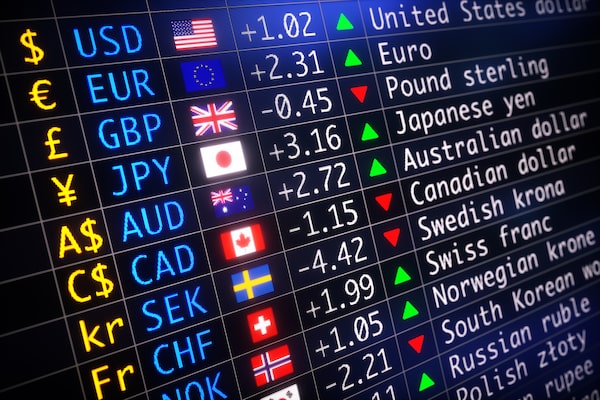
Fees on currency hedged mutual funds and exchange-traded funds are normally much higher than those of their unhedged counterparts, but they’re sometimes worth the extra cost.matejmo/iStockPhoto / Getty Images
For Canadian investors, portfolio diversification means investing outside Canada. Publicly-listed Canadian stocks account for less than 3 per cent of all stocks traded worldwide and roughly two-thirds of those are either finance or resources related. What might be harder to fathom is how currency fluctuations can impact overall returns for Canadians who invest their Canadian dollars globally and how world events in the coming year can sway performance.
The loonie was the world’s best performing major currency in 2019 – a blessing for Canadians investing abroad and a curse for Canadians looking to convert their foreign assets to Canadian dollars. The 2020 outlook for the loonie is mixed, but foreign-exchange experts agree that a currency strategy is vital for Canadians who invest globally.
In most cases, Canadians get global exposure through U.S. dollar-denominated investments. Edward Moya, senior market analyst with New York-based Oanda Corp., expects that a slightly stronger loonie in 2020 could open up foreign buying opportunities for Canadians as global trade tensions ease and demand for the safe-haven U.S. dollar wanes.
“You’re probably going to see a test of the 2019 highs easily. I think the Canadian dollar will trade through 77 cents [to the U.S. dollar] multiple times; 78 cents is a bit up there,” he says, adding that uncertainty over who will replace Bank of Canada Governor Stephen Poloz when his term ends in June and an easing of global oil prices will weigh on the loonie.
Oil prices, which have returned to normal levels after spiking in the aftermath of a U.S. attack on Iran earlier this month, have a big influence on the Canadian dollar because Canada is a major oil exporter. Mr. Moya says oil prices will remain vulnerable to geopolitical events in 2020.
“There are so many global risks that will affect the Canadian dollar, but if we see an improvement in the global growth outlook, Canada will thrive,” he says.
On the other side of the coin, Mr. Moya sees little movement for the U.S. dollar despite ongoing tension between the U.S. and Iran, the threat of a presidential impeachment and U.S. presidential elections in November.
“Right now, the U.S. dollar is not going to see any major changes from the [U.S. Fed Reserve Board]. The Fed is on hold indefinitely and that will be reflected by many central banks,” he says.
His advice for Canadians hoping to buy into a currency at a low point is to invest in Europe.
“I think you’re going to see a much firmer euro and the commodity currencies – the loonie, the kiwi [New Zealand dollar] and the Aussie [Australian] dollar – all outperform,” he says.
Karl Schamotta, chief market strategist at Toronto-based Cambridge Global Payments, is less optimistic about the loonie’s fortunes for 2020, citing weakness in consumer spending and a cooling of the housing market.
“We think the Canadian dollar will likely weaken by 3 cents [to the U.S. dollar] from where we are,” he says adding that 2020 could be a good year for Canadian investors to look beyond the U.S. greenback at currencies that were oversold over global trade concerns.
“Canadians tend to look at the U.S. dollar as a level against Canada, but Canada is a very small piece of the pie. The U.S. dollar could weaken but strengthen against the Canadian dollar,” he says. “We’re thinking the euro and [British pound] – perhaps even the Chinese renminbi – will come back a bit against the U.S. dollar, but the Canadian dollar falls in lockstep with the U.S. dollar.”
Regardless, Mr. Schamotta says Canadian investors should always have a diversified arsenal of currencies to hedge risk.
“For those looking to build wealth over time, I would suggest foreign currency exposure along with exposure to the underlying investments you’re making in those areas,” he says.
But security from hedging currencies has a price. Fees on currency hedged mutual funds and exchange-traded funds are normally much higher than those of their unhedged counterparts, but Mr. Schamotta says they’re sometimes worth the extra cost.
“If you’re a retiree who depends on a steady flow of income and needs that higher level of protection, it may be worthwhile to look at the hedged version of various funds,” he says.
Investors with a higher risk tolerance and an aversion to fees might consider unhedged funds, hoping the Canadian dollar will underperform other currencies. Others might hold off, waiting for the rare occasion when the Canadian dollar tops the U.S. dollar, such as 2011.
“That’s a very dangerous strategy to deploy,” Mr. Schamotta says. “Expecting the Canadian dollar to anchor back toward a level we reached in the past is not the way to do things.”
Mr. Moya is even more blunt about speculating when the Canadian dollar will eclipse the U.S. dollar again.
“There’s no way in the first half of this new decade where that’s even remotely possible, but you can never say never,” he says.